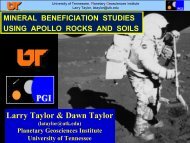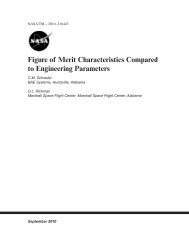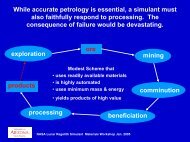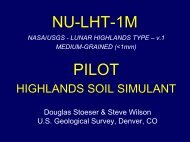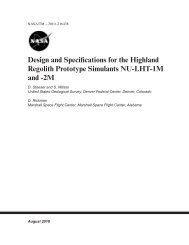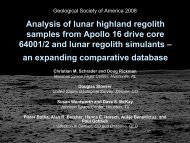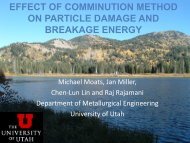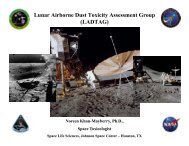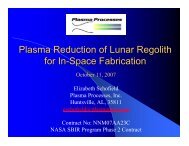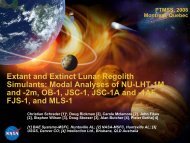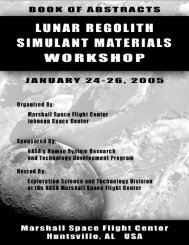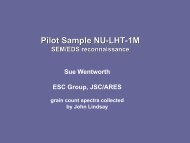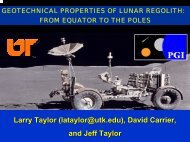Measurement of Particle Size and Shape Distribution For ... - Nasa
Measurement of Particle Size and Shape Distribution For ... - Nasa
Measurement of Particle Size and Shape Distribution For ... - Nasa
You also want an ePaper? Increase the reach of your titles
YUMPU automatically turns print PDFs into web optimized ePapers that Google loves.
1. Objectives<br />
The objective <strong>of</strong> this study was to provide size <strong>and</strong> shape distribution information on Lunar<br />
Highl<strong>and</strong>s Type simulant samples supplied by USGS-NASA.<br />
2. Background<br />
Two samples were submitted by USGS-NASA for measurement with image analysis techniques<br />
provided by Malvern Instruments Inc. The sample was:<br />
1 Lunar Highl<strong>and</strong>s Type simulant, medium grain size, NU-LHT-1M, 121<br />
2 Lunar Highl<strong>and</strong>s Type simulant, medium grain size, NU-LHT-1M, 026<br />
3. Materials (<strong>and</strong> form) <strong>and</strong> instrumentation<br />
Both samples were grey powders with larger black specks.<br />
Detailed image analysis <strong>of</strong> each sample was performed on the Malvern Instruments Morphologi<br />
G2 running version 5.01 s<strong>of</strong>tware.<br />
4. Method<br />
Image analysis was conducted on the Malvern Morphologi G2.<br />
Both samples were dispersed dry using forced air, which spreads the sample evenly on a glass<br />
plate. The plate with the particles was then scanned <strong>and</strong> a sufficient number <strong>of</strong> particles (~<br />
20000) were counted <strong>and</strong> sized for statistical validity. A wide variety <strong>of</strong> shape parameters can<br />
then be extracted <strong>and</strong> every individual particle has all the information saved along with the actual<br />
image itself.<br />
5. Assumptions<br />
Each lens on the G2 system is calibrated against a NIST-traceable graticule before it is used to<br />
measure the size <strong>of</strong> the particles. <strong>Shape</strong> parameters are calculated in line with the formulae given<br />
on the attachment. It is important to note that a sufficient number <strong>of</strong> particles need to be<br />
examined for statistical validity, especially if a conversion to volume is contemplated where any<br />
errors in the number distribution will scale accordingly (see attached Basic Principles <strong>of</strong> <strong>Particle</strong><br />
<strong>Size</strong> Analysis). The st<strong>and</strong>ard error <strong>of</strong> measurement is proportional to 1/n 0.5 where n is the number<br />
<strong>of</strong> particles. Thus for a st<strong>and</strong>ard error <strong>of</strong> 1% (= 0.01), then a minimum <strong>of</strong> 10000 particles should<br />
be sampled.<br />
6. Results<br />
Circular equivalent diameters based on volume <strong>and</strong> number along with circularity values are<br />
displayed in Tables 6-1 <strong>and</strong> 6-2 for samples 121 <strong>and</strong> 026 respectively. It should be noted that the<br />
Morphologi G2 is a number-based technique <strong>and</strong> volume-based results are derived from the<br />
number-based data.



